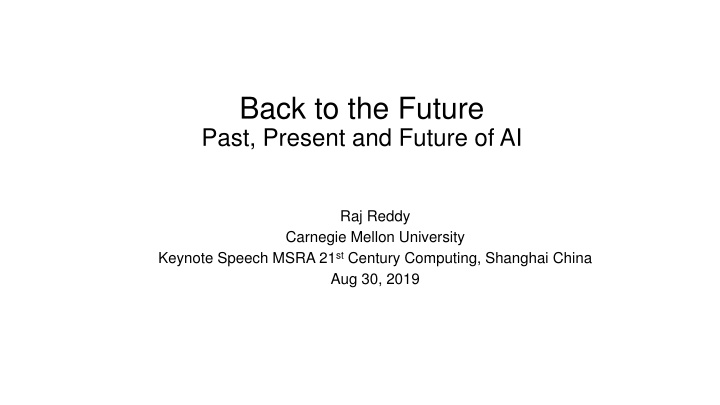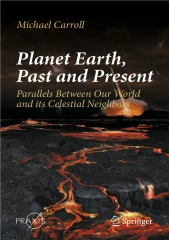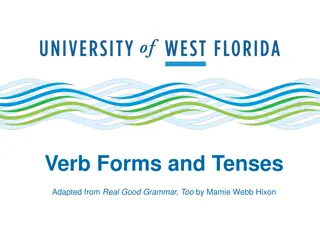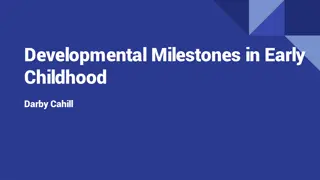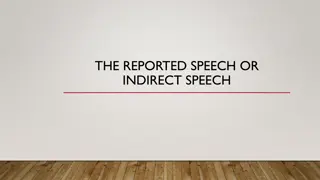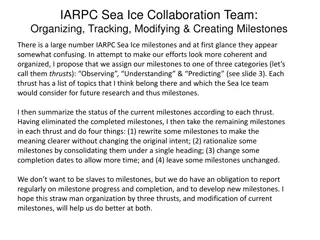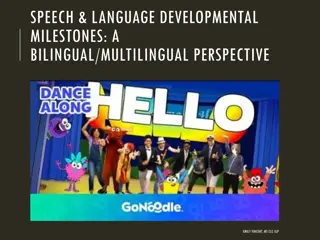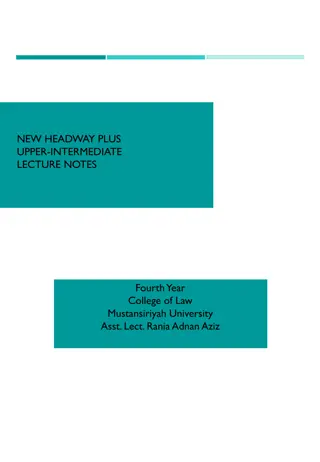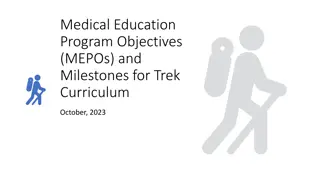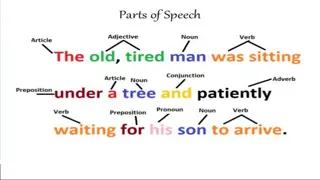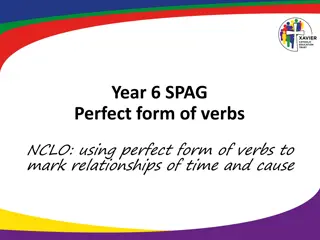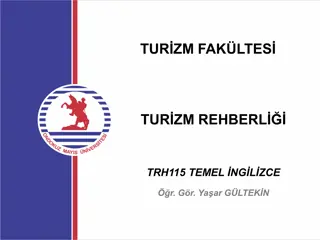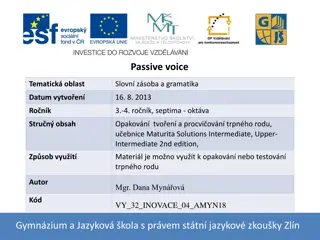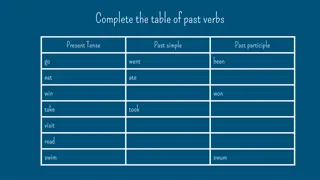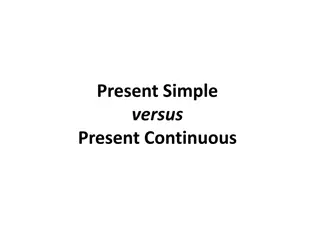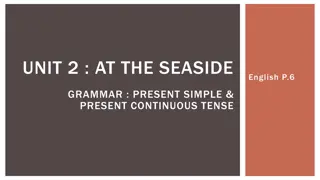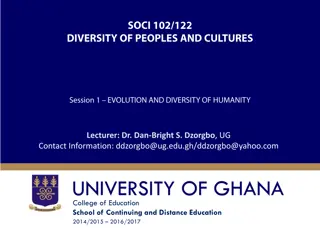Evolution of AI: Past, Present, and Future Milestones
Explore the history of Artificial Intelligence (AI) from the 1960s golden age to recent breakthroughs in speech recognition, robotics, and more. Delve into key projects at Stanford AI Labs, significant advancements in AI technologies, and reflections on the evolution of AI and computer science. Discover how AI has transformed over the decades and its promising future possibilities.
Uploaded on Sep 28, 2024 | 1 Views
Download Presentation

Please find below an Image/Link to download the presentation.
The content on the website is provided AS IS for your information and personal use only. It may not be sold, licensed, or shared on other websites without obtaining consent from the author.If you encounter any issues during the download, it is possible that the publisher has removed the file from their server.
You are allowed to download the files provided on this website for personal or commercial use, subject to the condition that they are used lawfully. All files are the property of their respective owners.
The content on the website is provided AS IS for your information and personal use only. It may not be sold, licensed, or shared on other websites without obtaining consent from the author.
E N D
Presentation Transcript
Back to the Future Past, Present and Future of AI Raj Reddy Carnegie Mellon University Keynote Speech MSRA 21stCentury Computing, Shanghai China Aug 30, 2019
Back to the Future Future AI Topics Will Be Similar to Those in the Past 50 Years Ago: List of Research Projects at Stanford AI Labs (SAIL), 1963-1969 Robotics: Led to Vision and Robotics Industry Mobile Robotics: Mars Rover and Stanford Cart Image Understanding: Led to Vision and Robotics at CMU and Penn Knowledge Engineering: Led to Expert Systems, Knowledge Engineering, Knowledge Based Systems Industry, and Early Applications of AI Speech Led to the DARPA Speech Understanding Project during the years 1971-76 Most influential branch of Speech Recognition Industry: Dragon Systems, Apple, Microsoft. Indirectly IBM and Bell Labs Language Understanding: Question Asking and Dialog Modeling Computer Music: Led to Yamaha adopting digital synthesis for consumer products Other AI Projects: Chess, Symbolic Mathematics, Correctness of Programs, Theorem Proving, Logical AI, Common Sense Computer Science: Time Sharing, LISP, DEC Clones, Graphical Editors, Pieces of Glass, Theory of Computation
Back to the Future Lead to Dramatic Breakthroughs 1970-2000 Breakthroughs World Champion Chess Machine: IBM Deep Blue Accident Avoiding Car: 1995 CMU No Hands Across America Robotics: Disaster Rescue Robots Speech Recognition Systems: Dictation Machine Computer Vision: Medical Image Processing Expert Systems: Rule Based Systems 2001-2018 Breakthroughs Translation: Google Translate: Any Language to Any Language Speech to Speech Dialog: Siri, Cortana, Alexa Autonomous Vehicles: CMU, Stanford, Google, Tesla Deep Question Answering: IBM s Watson World Champion Poker: CMU No Limit Texas Hold em Poker
Reflections on AI and CS at Stanford 1963 to 1969
1960s: The Golden Age of SAIL Robotics Computer Vision Knowledge Engineering Speech Language Understanding Computer Music Chess, Symbolic Mathematics, Correctness of Programs, Theorem Proving, Logical AI, Common Sense Time Sharing LISP DEC Clones: Foonly, Graphical Editors, Pieces of Glass, Theory of Computation
The Hand Eye Project Interaction with the Physical World Early work by Karl Pingle, Bill Wichman, Don Pieper Main Project Team Jerry Feldman, R. Lou Paul, Marty Tenenbaum, Gerry Agin, Irwin Sobel, etc. Robotic Hands Bernie Roth and Vic Scheinman Started in 1965 Using the PDP1 and later the PDP6 Led Machine Vision and Robotics Industry Via SRI and Vic Scheinman
Image Analysis and Understanding Image Analysis Manfred Hueckel, Ruzena Bajcsy, and Tom Binford Led to Vision and Robotics at UPenn Image Understanding Natural Scenes and Face Recognition Mike Kelly and Raj Reddy Led to Vision and Robotics at CMU
Mobile Robotics Mars Rover and Stanford Cart Marvin Minsky (visiting) Mars Explorer project 1964 Les Earnest Bruce Baumgart Lynn Quam Hans Moravec Rod Brooks (later in the seventies) Influenced direction of programs at SRI and MIT
Capturing Expertise Heuristic Dendral: Representation, acquisition and use of knowledge in chemical inference Project Team Ed Feigenbaum, Josh Lederberg, Bruce Buchanan, Georgia Sutherland et al. Started in 1965 Led to Expert Systems, Knowledge Engineering Knowledge Based Systems Industry Early Applications of AI
Speech Speech Input to Computers Started in 1964 as a class project Using a PDP1 with drum memory and a display By the end of 1964 we had a vowel recognizer running Project team in the sixties Raj Reddy, Pierre Vicens, Lee Erman, Gary Goodman, Richard Neely Led to the DARPA Speech Understanding Project during the years 1971-76 Most influential branch of Speech Recognition Industry: Dragon Systems, Apple, Microsoft Indirectly IBM and Bell Labs
Language Understanding Parsing and Understanding of Natural Language: Question Asking and Dialog Modeling Computer Simulation of Belief systems Ken Colby, Lawrence Tesler, Horace Enea et al Parsing of Non-Grammatical Sentences Colby, Enea et al Conceptual Parsing Roger Shank Led to Language Processing Industry via Shank and associates Led to other Language Processing groups at Yale and UCLA CMU, UMass, Berkeley, etc. Influential strand of Language research
Computer Music Computer Synthesis of Music Started in 1964 on PDP1 John Chowning Leland Smith Andy Moorer Impact Led to Yamaha adopting digital synthesis for consumer products Establishment of a Center in Computer Music in Paris
Other AI Projects Chess and other game playing programs Kalah: R. Russell Chess: McCarthy, Barbara Huberman (Liskov) Checkers: Art Samuels Symbolic Mathematics Algebraic Simplification: Wooldridge and Enea Reduce: Tony Hearn Proving Correctness of Programs Correctness of Programs: McCarthy and Painter Equivalence of Programs: Kaplan and Ito Properties of Programs: Zohar Manna Theorem Proving David Luckham and John Allen Use of Predicate Calculus as a Representation for AI McCarthy, Cordell Green et al AI and Philosophy McCarthy and Pat Hayes Programs with Common Sense McCarthy, later by Doug Lenat
Non-AI Research at SAIL Programming Languages LISP Symbolic Computation Dynamic Storage Allocation and Garbage Collection Forerunner of Functional Programming SAIL LEAP Associative Data Structure Feldman and Rovner Time Sharing and Real Time Systems Graphics Scan Line Graphics! User Interfaces Graphics Text Editors And Graphical Debugging Theory of Computation Semantics of Programming Languages What do strings of symbols representing programs denote! Data Spaces (aka Data Structures) Team: Earnest, Russell, Weiher, Poole, Panofsky, Sauter, Baumgart, Quam, Swinehart et al
Non-AI Research at SAIL (Cont) Representation of Time Dependent and Simultaneous Processes Speed of Computation (aka Computational Complexity) Storage of Information (aka Databases) Syntax directed computation such as computations described by productions and rule based systems Equivalence of programs Halting problem for practical cases
Other Innovations Film Reports Ellis D. Kropotechev and Zeus, his Marvelous TSS, Gary Feldman Butterfinger, Gary Feldman Hear Here, Raj Reddy, Dave Espar, and Art Eisenson Avoid, Gary Feldman and Don Peiper #?+@, Anon Use of displays and video terminals Early use of Laser Printing
Looking back: What we missed! Personal Computers! Alan Kay s dynabook vs Apple and PCs Internet and the WWW ARPAnet in 1968 with Stanford as one of the initial nodes Moore s Law and VLSI Graphics Human Computer Interaction UI design
Looking Back: Off in Timing! Speech Vision Robotics Natural Language
Future Opportunities Knowledge as a Service (KaaS)
Near Term Societal Impact of AI Existing AI Technology Can be Used to Empower the 3 Billion People at The Bottom of the Pyramid
Bottom of the Pyramid: 3 Billion People 3 Billion People with Incomes of less than $3 a day The Bottom of The Pyramid is The Largest, But Poorest Socio-economic Group. Globally that is the 3 billion people who live on less than say $2.50 per day. Most of Them Are Also Semi-literate, i.e., Cannot Read, Write and/or Understand Any Language Cannot use Keyboard or Touch based Computing Apps For a Semi-literate Person, the Only Acceptable Mode of Communication is Speech Voice Computing a la Amazon Echo and Enhancements is the Key Personal Assistants that Require Only Speech based Interaction is Essential for Such Populations
Technology Exists to Create Voice-Only Apps Speech to Speech Exists (Microsoft, Facebook and Others) BTW, Current Implementations are Based on Incorrect Business Assumptions Available only for Commercial Languages Will Never Result in Killer Apps English to Chinese Speech to Speech Translation Demonstrated in 2012 Text Based Translate App of 2016 has to become Speech Based Languages Supported Based on Commercial Viability Not Need based Unlikely to result in Killer App Apps Tailored to Semi-literate Populations Will Become Killer Apps 1 Minute Learning Time; Two clicks; and Spoken Dialog All Such Apps Will Require Speech Recognition, Spoken Dialog, and Speech to Speech Translation (No Keyboard or Touch) Speech to Speech Translation Entertainment (Movies) and Education (Khan Academy) Translate Live Dialog QA Dialog (Siri and Cortana) eCommerce and eBanking English Language Learning - Detect Pronunciation Errors
Applications for the Bottom of the Pyramid Voice Computing (No Keyboard or Touch) Can Help The Semi- literate to Read Newspapers, Watch Foreign Language Movies, Listen to Khan Academy Lectures, Vote Online and Order Groceries Online A Mobile App for Entertainment and Education Dynamic Real-time Translation of a Video Dialog from English to Telugu Text to Speech App for Newspaper Reading Assistant Enabling Digital Democracy Vote Online (Authentication, Authorization and Audit) Ecommerce and eBanking Voice Authentication, Authorization and Audit Learning Without a Teacher Tutor for Listening and Speaking English Illiterate Populations Will be the Biggest Source of Customers for Speech Based Apps in the Future
Typical Apps for the Semi-literate: NextGen Siri and Alexa An Intelligent Agent That Anticipates What You Want To Do And Helps You To Do It Using Local Language and Clarification Dialog Entertainment and Education: Streaming Video Translation Alexa play Hamlet (BBC Shakespeare) Reading Newspapers: Text to Speech Translation and/or Synthesis Alexa read China Daily Buying and Selling: Voice Dialog Management Alexa order usual brand Rice, Meat and Vegetables Communication: Voice and/or Video Email, Chat Alexa call my Grandson in Shanghai Banking: Monitor Bank account, Pay Bills Alexa charge my mobile device with 1000 rupees Online Voting Voice Dialog to enable the Authorization, Authentication and Audit Semi-literate Populations Will be the Biggest Source of Customers for Speech Based Apps in the Future Resulting Doubling of Net Users and Quadrupling of Economic Activity
AI : Near term Future (2 to 3 Years) Cognition Amplifiers That Enhance Human Capabilities Do Tasks Faster and with Less Effort
Cognition Amplifiers in Service of Society A Cognition Amplifier (COG) is an Intelligent Agent that anticipates what you want to do and helps you to do it Cognition Amplifiers Enhance Human Capabilities Do Tasks Faster and with Less Effort A Cognition Amplifier (COG) is a Personal Enduring Autonomic Intelligent Agent that Anticipates what you want to do and does it Always On, Always Working, Always Learning 26
Examples of COGs in Service of Society COGs personalized and mass customized agents as part of Knowledge as a Service (KaaS) may be Used by Everyone on the Planet for tasks such as Buying and selling: Transact with multiple providers Email: Filter spam, understand and respond to actionable email News: Based on topic preferences, novelty, collaborative filtering Banking: Monitor bank account, Credit Cards, Pay Bills Travel: Flights, hotel, schedule disruptions, cancellations Each Person May Have Thousands of Cogs as Personal Assistants
AI: Longer Term Future (5 to 10 Years) Guardian Angels That Enable Humans to Do Tasks They Cannot Do Today. Super-Human AI?
Guardian Angels in Service of Society Discover and Warn Humans About Unanticipated Events Impacting Safety, Security, and Happiness Guardian Angels Enable Humans to Do Tasks They Cannot Now Do. Super-Human AI? A Guardian Angel (GAT) is a Personal Enduring Autonomic Intelligent Agent Always On, Always Working, Always Learning 29
GATs in Service of Society GATs are personalized and mass customized agents as part of KaaS for Just-in-Time Warnings: Hurricanes, Earthquakes, Extreme Weather Act as Coach in Health and Education Matters Accident Alerts and Rerouting; Transport Strikes Scarcity of Essential Resources: Food, Energy, Water etc. Assume Everyone on the Planet has Personalized Guardian Angels (GATs)
Personalization and Customization of Guardian Angels Cloud Based Guardian Angel Platform Linked to User Smart Phone Learning Learn by Watching Learn by being taught Learn by doing Learn by asking others Learn by discovery Security Multimodal authentication Continuous authentication Encryption Dialog Self Healing Detect errors Resolve errors Big Data Management Process, index, story and retrieve data Mine, Cluster, and Summarize relevant experience With humans With other agents Power Mgmt Activity Monitoring Multi-Sensor Integration Autonomic Systems Etc. Family of Personalized Guardian Angels Subscribe to Local, National and Global Sources and Act on Relevant Information
KaaS Publish/Subscribe Eco System of Guardian Angel Global Infrastructure Platform Activity Monitoring and Intention Awareness User Guardian Angels Cloud Based User Infrastructure Platform Knowledge Source Publishers Global, National and Local Knowledge Source Distributors ReTweet Model Global DataBase of Humankind
In the Future AI will Enable KaaS Human Machine Augmented Intelligence AI and KaaS Will Become the Backbone of Emerging Industries Technology, Tools, and Techniques of KaaS will be the Main Activity of AI Sub-Human Level AI >>> Human Level AI >>> Super Human AI We have a million times more computing power than 1980s! By 2040, We Will Have Million Times More Computing Power Million Times More Memory Million Times More Band Width As McCarthy Said in 1980, We May Need 1.7 Einsteins, 3 Maxwells and 0.7 Manhattan project to get to Super Human AI
